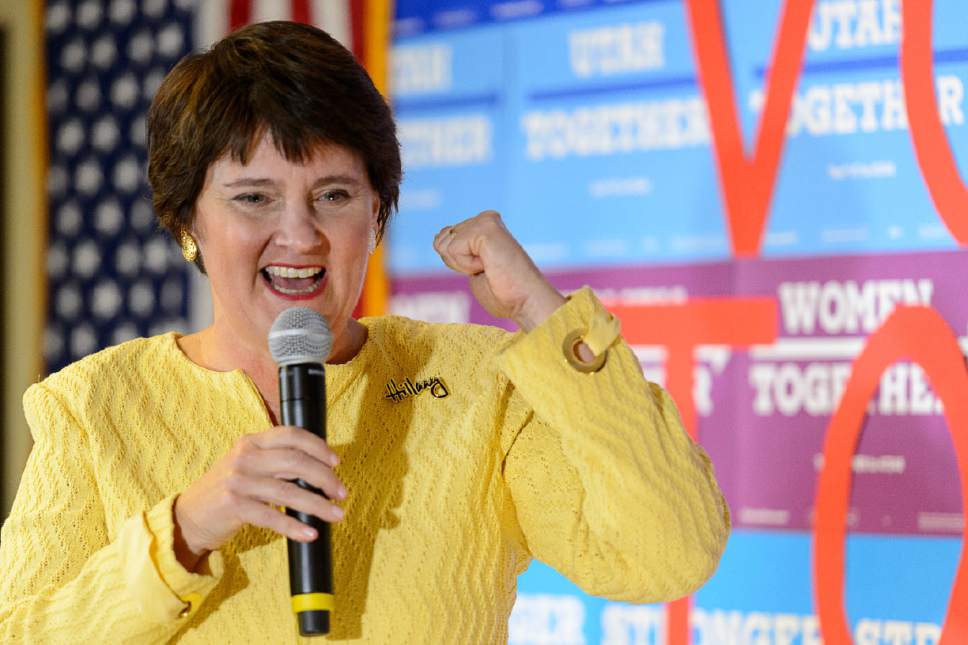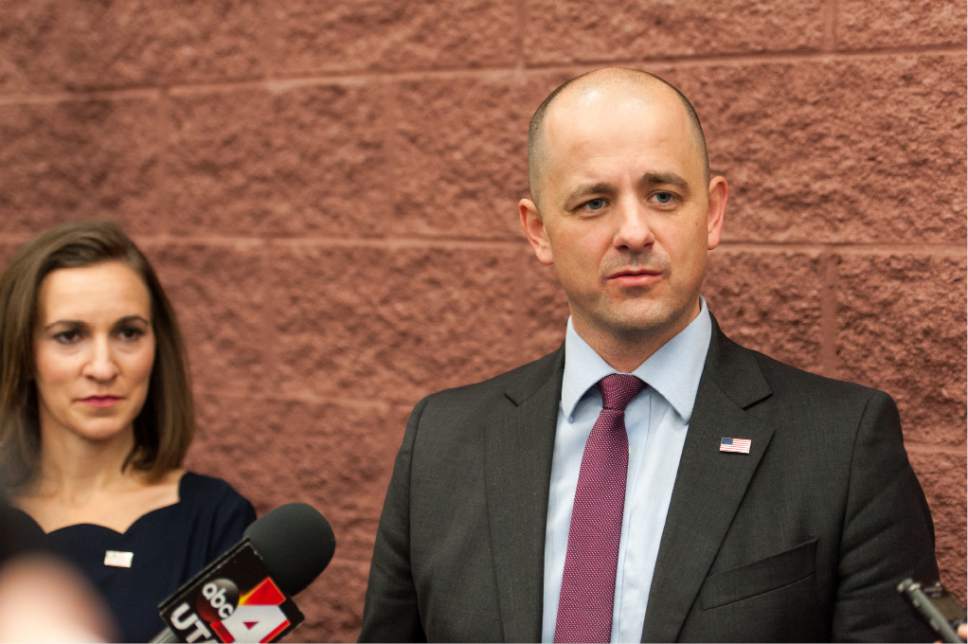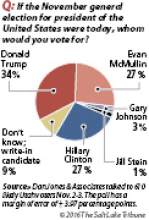This is an archived article that was published on sltrib.com in 2016, and information in the article may be outdated. It is provided only for personal research purposes and may not be reprinted.
It may be premature for Donald Trump to chalk up a win in Utah.
Three new polls released Friday, two by Utah's most prominent polling firms, reflect fairly consistent results, with the Republican presidential nominee holding a lead in the reliably red state, but with independent insurgent candidate Evan McMullin and even Democrat Hillary Clinton potentially within striking distance.
A poll conducted for The Salt Lake Tribune and the Hinckley Institute of Politics by Dan Jones & Associates shows Trump leading McMullin and Clinton by 7 percentage points, with 34 percent for Trump, and Clinton and McMullin knotted at 27 percent.
Trump is sitting at 33 percent in a second poll, conducted by Utah-based Y2 Analytics, with McMullin trailing at 28 and Clinton lagging further behind at 24 percent.
The Utah race is still fluid, according to the Y2 poll, which found that 5 percent of Trump voters, 7 percent of McMullin supporters and 2 percent of Clinton backers could still change their minds in the final four days before Election Day.
And a third poll by Gravis Marketing found a similar lead for Trump, this time leading Clinton, 35 percent to 29 percent, with McMullin in third at 24 percent.
The new survey results paint a different picture of the contest — and possibly a more troubling one for Trump — than three polls that were released Thursday.
Two of those Utah surveys — one by Emerson College and one by Rasmussen Reports — showed Trump with a whopping 12-point and 11-point edge, respectively. The third by Monmouth University showed Trump leading Clinton by 6 points, 37 percent to 31 percent, with McMullin well back at 24 percent.
So why such a wide disparity?
Veteran pollster Dan Jones, whose firm conducted the poll for The Tribune, said pollsters try to assess what the voter pool will look like in any given election and weight their results accordingly. Those assumptions can result in discrepancies between polls conducted over a similar time frame.
The Emerson poll also appears to have a strange anomaly reflected in the percentage of voters who said they voted for Trump in Utah's Republican primary. Twenty-two percent of all respondents — Republican, Democrat and unaffiliated — said they voted for Trump in the GOP primary, but Trump finished third in that primary with just 14 percent of the Republican vote and fewer than 10 percent of the total votes cast in both the Republican and Democratic primaries.
At the end of the day, amid all the data, Jones said he believes Trump will hold on to win Utah, which would continue GOP dominance in the state, which hasn't voted for a Democratic presidential contender since Lyndon Johnson in his 1964 landslide over Barry Goldwater.
"Where it turned around for McMullin is when [Republican vice presidential nominee Mike Pence] came and then the Republicans started coming home," Jones said. After that, Reps. Jason Chaffetz and Chris Stewart, who had said they weren't going to vote for Trump, did an about-face and announced their support.
"It's going to be real close between McMullin and Hillary. McMullin might hang on for second," Jones said. That outcome could hinge on how many millennials — those voters between ages 18 and 34 — actually vote.
"I can't remember an election where the millennials can make such a difference if they turn out," Jones said.
The Y2 survey gives a slight edge to McMullin over Clinton because of those millennial voters.
Trump does his best among older voters who have been surveyed, but in the past two presidential elections, the 18-34 age group has made up between 27 percent and 29 percent of the electorate and many polls have not adequately reflected that.
Those younger voters are harder and more expensive for pollsters to contact because they largely rely on cellphones as opposed to landlines.
"In Utah in 2016, the strong relationship between age and vote choice makes it essential for pollsters to get enough young voters in their samples," Quin Monson and Scott Riding of Y2 wrote in a memo outlining their results.
Other findings from Friday's polls included:
• Gov. Gary Herbert continues to hold a dominating lead over Democrat Mike Weinholtz, with The Tribune poll showing Herbert leading 63 percent to 27 percent and the Y2 poll putting the margin at 64 percent to 26 percent. Jones is also Herbert's campaign pollster.
• U.S. Sen. Mike Lee is leading Democratic challenger Misty Snow, 62 percent to 22 percent, according to the Y2 poll.
The Tribune poll was conducted Nov. 2-3 by Dan Jones & Associates by contacting 610 likely voters through interviews on a mix of landlines and cellphones, as well as some online surveys. The margin of error is plus or minus 3.97 percentage points.
The Y2 Analytics poll relied on landline and cellphone surveys of 500 likely voters contacted between Nov. 1-3. It has a margin of error of plus or minus 4.38 percentage points.
And the Gravis Marketing poll contacted 1,424 registered Utah voters between Oct. 30-31, using automated phone calls and online cell respondents. The margin of error for that survey is plus or minus 2.6 percentage points.
Twitter: @RobertGehrke Below is a list of the presidential polls released in Utah in the past two weeks and the average results from those findings:
The Salt Lake Tribune-Hinckley Institute/Dan Jones: Trump 34, Clinton 27, McMullin 27
Y2 Analytics: Trump 33, Clinton 24, McMullin 28
Gravis Marketing: Trump 35, Clinton 29, McMullin 24
Emerson Poll: Trump 40, Clinton 20, McMullin 28
Monmouth University: Trump 37, Clinton 31, McMullin 24
Heat Street/Rasmussen: Trump 42, Clinton 31, McMullin 21
Tribune/Hinckley/Dan Jones (Oct. 20-27): Trump 32, Clinton 24, McMullin 30
Heat Street/Rasmussen: Trump 32, Clinton 28, McMullin 29
Emerson University: Trump 27, Clinton 24, McMullin 31
Average Results: Trump 34.7, Clinton 26.4, McMullin, 26.9







